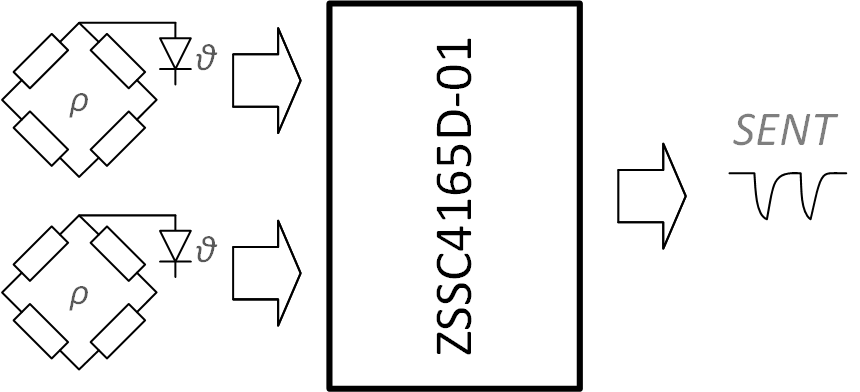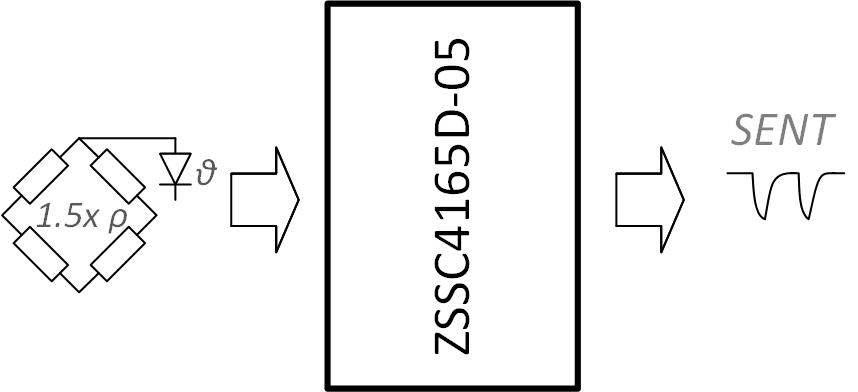Features
- Bridge Measurement
- Two full Wheatstone bridges (ZSSC4165D-01)
- One full bridge + one half-bridge branch (ZSSC4165D-05)
- Two independent Wheatstone bridges (ZSSC4165D-06)
- Temperature Compensation
- External P/N junction or internal PTAT (ZSSC4165D-01)
- Internal PTAT only (ZSSC4165D-05)
- External RTDs (PTC) or internal PTAT (ZSSC4165D-06)
- A/D Conversion Resolution
- 14 to 18 bits (ZSSC4165D-01)
- 14 bits (ZSSC4165D-05)
- Up to 18 bits (ZSSC4165D-06)
- Sample Rate
- Up to 0.95kHz (ZSSC4165D-01)
- Up to 1.16kHz (ZSSC4165D-05)
- Up to 1.00kHz (ZSSC4165D-06)
- Functional Safety
- Not specified (ZSSC4165D-01)
- Supports ASIL B (ZSSC4165D-05)
- Not specified (ZSSC4165D-06)
- Temperature Sensor Inputs
- 2 external diodes + internal (ZSSC4165D-01)
- Internal only (ZSSC4165D-05)
- External RTDs + internal (ZSSC4165D-06)
- Bridge Sensor Diagnostics
- Full bridge connection checks (ZSSC4165D-01)
- Full and half-bridge diagnostics (ZSSC4165D-05)
- Full bridge diagnostics (ZSSC4165D-06)
- ADC Features
- Flexible input range, auto-zero compensation (ZSSC4165D-01)
- Optimized for single bridge + branch (ZSSC4165D-05)
- Flexible input range, auto-zero compensation (ZSSC4165D-06)
Description
The ZSSC4165D is a high-performance CMOS IC for precise amplification and correction of Wheatstone bridge sensor signals. With digital compensation for offset, drift, and nonlinearity, it delivers excellent accuracy and reliability. Various self-supervision mechanisms allow monitoring for correct functionality during operation. Integrated non-volatile memory and digital calibration reduce assembly costs and eliminate external trimming. Focused for automotive use, the ZSSC4165D offers robust protection, excellent EMC, and easy calibration via I²C or OWI interface, making it the most efficient, cost-effective solution for sensor signal processing.
An extension to ZSSC4161D and ZSSC4162D, the ZSSC4165D offers measuring up to two independent Wheatstone bridges.
The ZSSC4165D comes with three different product derivatives:
The ZSSC4165D-01 is optimized for SENT output interface and offers measurement of two Wheatstone bridges and temperature compensation with an external P/N junction or internal temperature source. Bridge input signal amplification up to 200, A/D conversion up to 18 bits, and sample rates up to 0.95kHz.
The ZSSC4165D-05 is optimized for SENT output interface and offers measurement of one Wheatstone bridge and additional measurement of one-half bridge branch of the same Wheatstone bridge, and temperature compensation with an internal temperature source. Bridge input signal amplification up to 200, A/D conversion with 14 bits, and sample rates up to 1.16kHz. Operation in functional safety systems up to ASIL B is supported.
The ZSSC4165D-06 is optimized for SENT output interface and offers measurement of two independent Wheatstone bridges and temperature compensation with external RTDs (PTC) or an internal temperature source. Bridge input signal amplification up to 200, A/D conversion up to 18 bits, and sample rates up to 1.00kHz.
Parameters
| Attributes | Value |
|---|---|
| Function | Resistive SSC |
| Automotive Qual. | Yes |
| Supply Voltage (V) | 4.5 - 5.5, 4.75 - 5.25 |
| Input Type | Dual-bridge, Dual-Bridge, Temperature Diode, PTC, NTC |
| Interface | SENT, I2C, SENT, ZACwire™, I2C |
| Adj. Analog Gain | 1 - 200, 2.1 - 200 |
| Resolution (bits) | 14, 18 |
| Sample Rate Max (KHz) | 0.9, 1.16 |
| Temp. Range (°C) | -40 to +150°C, 0 to +70°C |
Application Block Diagrams

|
Automotive Sensor with CAN/LIN Interface
Automotive sensor system offers accuracy, flexibility, and reliable performance with SSC, MCU, LIN/CAN support.
|
Additional Applications
- Dual single-ended pressure measurement with optional media temperature
- Differential pressure with optional medium temperature (e.g., exhaust systems)
- Flow and temperature measurement for gas or fluids with the differential pressure method
Applied Filters:
Filters
Software & Tools
Sample Code
Simulation Models
Modern vehicles are filled with complex sensor systems to achieve optimal performance and lower emissions. IDT's (acquired by Renesas) ZSSC416x and ZSSC417x family of sensor signal conditioner ICs are ideal for use in the engine and exhaust system. Sensing differential pressure at the mass airflow intake using a single IC attached to two sensors lowers power consumption and improves accuracy compared to traditional sensing systems. Manifold pressure and temperature sensing also benefit from using a dual input IC, with higher accuracy measurements resulting in a more optimal fuel mix.
The IDT ZSSC416x and ZSSC417x family of sensor signal conditioners provide a platform for measurement systems with improved accuracy, reliability, and performance with lower power consumption. The family of devices provides highly accurate amplification with integrated compensation, correction, and calibration, while also sharing a common four-millimeter by four-millimeter QFN package and toolset to reduce development and assembly costs.
Related Resources
ZSSC416X and ZSSC417X provide highly accurate amplification and calibrated correction of sensory data for resistive bridge and voltage source sensors. The family features SENT 3.0-based ICs and is designed for use in automotive applications. With available diagnostic info, rugged circuit protection, and excellent electromagnetic compatibility.
The family aids designers by lowering power consumption, reducing component count, and saving time spent calibrating sensors. Additionally, the availability of dual-bridge inputs also reduces system complexity and footprint. All of these are important considerations in modern automotive applications where power and space come at a premium.
Related Resources
SENT (Single Edge Nibble Transmission) is a unique serial interface/protocol originally targeted for automotive applications. Engineers are using this interface with sensors for applications such as throttle position, pressure, mass airflow, and high temperature. IDT provides sensor signal conditioners that function using the SENT interface.
The video reviews the three main SENT transmission protocols: fast channel read, short serial message format, and enhanced serial message format. It will cover the SENT signal's basic terms, definitions, and abbreviations, what is required to decode the SENT signal, and how to determine which SENT format applies to each application. It will cover the advantages of a SENT output vs. analog output and show an example of a sensor interface using SENT 3.0.
Related Resources
A brief introduction and overview of IDT's (acquire by Renesas) sensor signal conditioner evaluation kits. Evaluation kits generally consist of three parts: a communication interface board, a device board, and a sensor simulator board - all connected together. A sophisticated software GUI accompanies the kit, enabling an engineer to learn how to use the part rapidly, do quick prototyping, and practice calibrations.
Presented by David Grice, applications engineer at IDT. For more information about IDT's sensor signal conditioner products, visit the Sensor Signal Conditioner page.





